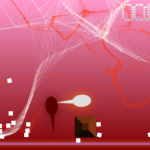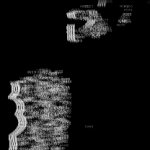Chemical Reactions
September 6, 2011 - Mixtapes
This is up a bit late. I blame Labor Day! Also, getting swamped at work. Anyway, last week I was mainly playing through last May’s Experimental Gameplay Project entries, with the theme of “ZOOM.”
The Camera Made Me Fat! and Broken Zoomometer [direct download link]
Both of these games use a pretty straightforward interpretation of the theme: scrolling in and out makes your avatar grow or shrink while the rest of the level stays the same size. There’s nothing too deep going on here, but it turns out that this is a pretty fun mechanic. Both games also use chaotic, hard-to-control movement schemes, which adds a lot of entertainment value when the physics of your avatar keep changing.
Secondario: Mushroom Overdose
From Alexis Andre, a Mario clone in which you a) have only ten seconds to finish each level and b) are constantly growing larger. In practice, this means a lot of micro-Mario levels with very precise jump timing. If you are not great at platformers, this is a good game to make you furious! The neat thing about this game is that it dramatically throws off your ability to predict how your avatar will respond to your actions. It’s very hard to teach yourself not to judge jumps by your current size, but by the size you’ll be when you land. Freaky stuff.
Chrysopoeia
This entry from One Life Remains is by far my favorite of this month’s entries. You are a small red square who regularly generates little blocks with words on them. Those little blocks are drawn to other blocks of the same color, and when they combine they get bigger. Each color also has its own movement behavior. When enough of them combine, you can finally read the word that’s written on them. And if any block touches you, you die.
This basic setup produces a lot of nuance in the gameplay. It’s a bit safer to have a few large blocks rather than a lot of small blocks, so a good strategy is to try to drop your blocks so that they combine with others already on the field. Of course, this means getting close to existing blocks, which is dangerous itself. Growing blocks is also how you figure out what they say, which is the real motivation to the game. I was able to decipher “vision,” “serial,” “stance,” and “preform.” One type of block – black with orange border – continually eluded me, even after about half an hour of desperate attempts to build it up to legibility.
Chrysopoeia means turning lead into gold. What it means in the context of the game isn’t obvious, but the gameplay here could serve as a metaphor for many things. I thought of it as the artistic process. You’re building something, but you’re not sure what it is yet, and if you try to jump the gun you’ll ruin it. Beautiful game.
A Closed World
I came on this one via Robert Yang. Yang’s blog has a critique of the game from the perspective of LGBTQ media pitfalls, and one of the developers showed up in the comments to argue for his work. It’s a great discussion, check it out. For my part, I was mostly interested in the game because it uses combat-style conversation mechanics. It’s basically a rock-paper-scissors thing: enemies have three attack styles, and you have three defense styles, each of which is strongest against one attack type. In a battle, you figure out which attack your enemy is using against you, and counter with the strongest defense. Sometimes the enemy blocks out one of your tactics. You can also “breathe” to regain health.
So it’s not anything too sophisticated, but I still like to see people trying. It’s also interesting to see a game that runs into the problem suggested by Ari in a comment on one of my Mouthwash posts: won’t combat-like dialogue get annoyingly repetitive? Your mileage may vary, but in the case of A Closed World, I found myself reacting differently to the unvoiced dialogue of the enemies and the worded dialogue of my avatar. By unvoiced dialogue I mean something like “The demon taunts you!” as opposed to worded dialogue like “Why won’t you let me live my life?” I tuned out the unvoiced dialogue pretty quickly. I perceived it as an indicator of the game state, and abstracted it accordingly. But the worded dialogue, which was repeated, did get annoying, even in something as short as A Closed World. A useful lesson for the future of conversation systems, I think.



